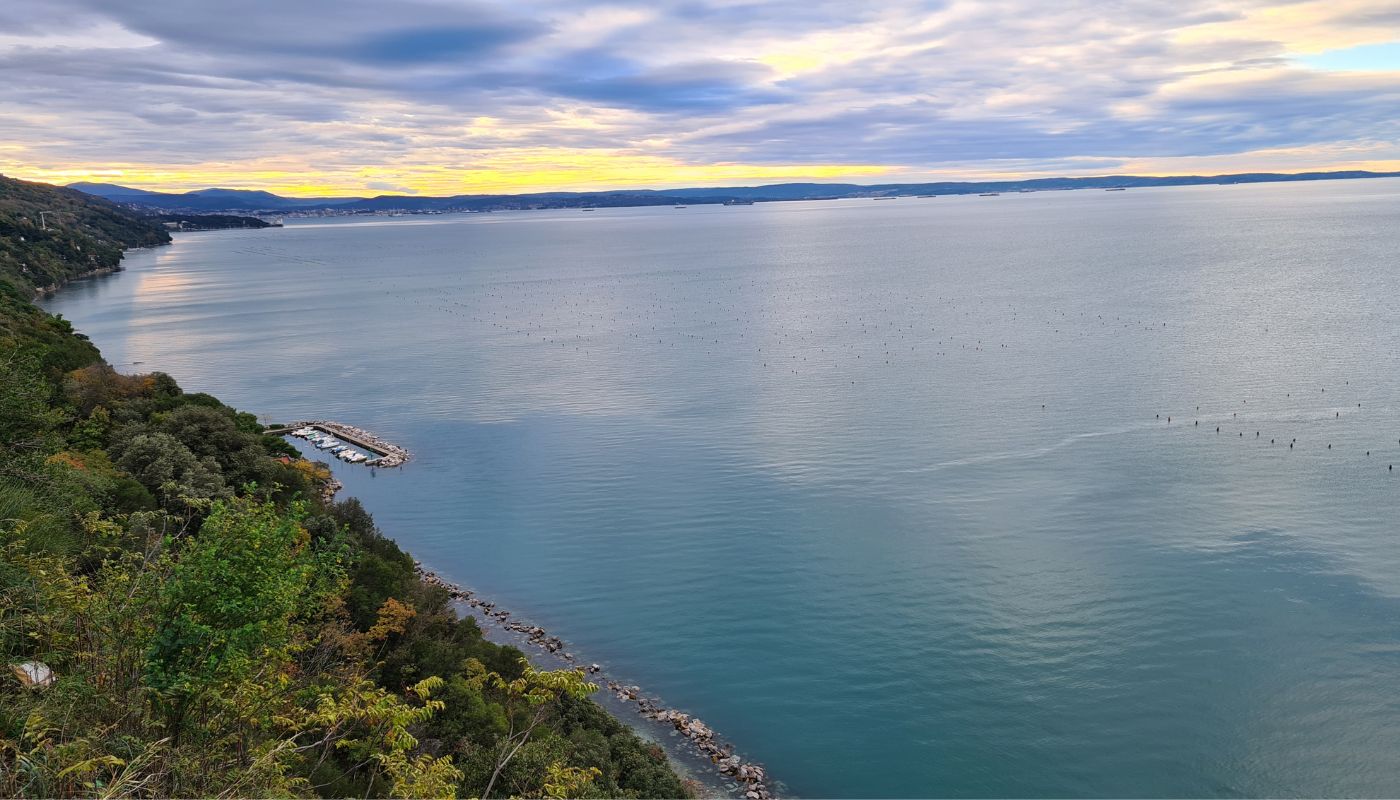
WHEN GUIDO PIOVENE VISITED OUR LANDS
by ANDREJ DROSGHIG
I had never heard of Guido Piovene before a lucky meeting, at a second-hand stall: Journey to Italy, his best-known work. Leafing through a few pages, I was immediately struck by the gaze of a faithful observer, who reworks and reflects, but separates what he sees from what he thinks of it; A book at the same time journalistic, documented, and extremely cultured – with a few brushstrokes of poetry here and there. There is no shortage of judgments that are hard to digest today: but it was the 50s and it is to be seen, in my opinion, as a child of that time.
The journey from which the book is based – which reproduces texts used for a radio broadcast – took place from May 1953 to October 1956. These are the times of the youth of my grandparents and other of their peers, dear to me; the times when (trivializing their nostalgia) “The war was over, it was hard, but with little you were happy, and we knew that we were going for the better”. Their stories find their place perfectly in the picture traced by the book; It’s just the setting I’ve always needed. As Piovene travels around Italy province after province, he stops to observe local, or general, transitory or lasting dynamics and phenomena and (perhaps) distinctive of the character. A recurring theme in Piovene is, for example, the increase in needs: he says of Umbria, but it could very well be applied to any of our rural areas: ” The balance rests, or rested until some time ago, on the scarce need for consumption, on the lack of appetite for goods. (…) “And he describes the changes as “withdrawal fatigue, need to have needs“.
Specifying that “I don’t do interviews, I consider them useless, I’m interested in meeting men, characters“, Piovene reports the opinions of industrialists, prelates, artists, intellectuals, as well as people met on the way. It reports statistical data on the current situation, especially economic; At the same time, however, he also paid great attention to the unrepeatable things that he saw most threatened by the tumultuous change of those years: traditions undermined by new lifestyles, landscapes and historic centers under the blows of building speculation. What he sees, he often points out, is a snapshot.
When in 1953 Piovene reached our Region, this did not yet exist administratively and was included in the “three Venices”. Entering the Pordenone Friuli from his native Veneto, he lives it as” the passage through which one escapes an excessive beauty, the taste of freedom and the unknown” with its “solitary mountains from which purple shadows descend into the plain”. And then Udine, where he met the then archbishop Monsignor Nogara, the castles of the morainic hills with its fallen nobility, the Friulians closed and silent people, ” the strange sensation of a cinema in color but silent and without music”. Pordenone, with the agricultural arrangements of Meduna-Cellina, Cividale, with its Mass of the Broadsword appreciated by the Americans then stationed in Trieste, Grado with its elderly women praying in Santa Maria delle Grazie, ” exaggerated specimens of the grandmothers of Veneto, the country in the world where the grandmother has the most importance“, Aquileia with its “most beautiful mosaics in the world” and finally Venzone, with its mummies.
Among the major issues, autonomy. “As in South Tyrol I have listened to long diatribes on the autonomy achieved, here I listen to arguments on the autonomy to be achieved. (…) I wonder how many people know that the autonomy of Friuli has already been granted by the Constituent Assembly in 1947, and kept in abeyance. This law, which not everyone approves, should unite three cities, Trieste, Gorizia and Udine, in a single autonomous region. Capital Udine, at least according to the Friulians. (…) The arguments for autonomy are cultured, a mixture of Europeanism and folklore. The originality of Friuli has never been denied through the centuries. With its one million inhabitants, this is a meeting place of three civilizations, Latin, Slovenian and Germanic, and three races in harmony. “
Going down to Trieste, here is Gorizia.
“Gorizia was a gay bourgeois town. (…) A sorting centre between the valleys of the Isonzo and Vipava rivers and the Udine and Po Valleys, an emporium of artisanal and agricultural production in the valleys that are now Yugoslavia, Gorizia was above all a market. Now trade is dead, the commercial class is declining and yet no one emigrates. Among Italian cities, Gorizia has perhaps the highest percentage of unemployed. To the east there are large forests, but the border that passes close to the town has also deprived it of its woodland heritage. Attempts have been made to replace commerce with industry by means of a free industrial zone, but with little relief: the future depends on the diligence of the government. Slovenes are about a tenth of the approximately 40,000 inhabitants: small closed associations living on their own. Even in the most tense moments, order was guaranteed by the innate respect for the law of these areas. The green landscape, the villas, the cleanliness of the city and the polite demeanor of the inhabitants pretend a cheerful and even comfortable life. But I already feel the sadness of the division dug by years of bad politics between races once linked by ancient customs of patriarchal coexistence.” He went to see the border of the Transalpina, and reported on a wedding that took place “on this side” with the Slovenian guests who remained on the other side of the border to say goodbye.
He also speaks of the Slovenes in Trieste: closed and impenetrable on the little Karst left to Italy, almost invisible in the city. He arrived in Trieste two months after returning to Italy; This is the feeling of the moment. “One is afraid of the qualities of the Slavs: dissimulation, obstinacy, cohesion of minds, the thirst to assert oneself and to cultivate oneself, and underneath, I have been told, “a powerful, insatiable appetite.” They are inferior in culture: will they be tomorrow?” In Trieste, “the best built of our ports“, he reasons at length with an economist (whose name he does not mention) on the nature of the city: “As a great city, Trieste was a political-Enlightenment creation of the Austro-Hungarian empire at the beginning of the eighteenth century. (…) The quality of its origin makes Trieste subject to any variation of the political map (…), to a greater or lesser extent Trieste will always need the assistance of the State.” There he then met the president of the Industrial Port Authority of Trieste, lawyer. Forti, who complains that “those (…) they decide its fate they do so abstractly, ignoring the environment of a special city”. Finally, the interview with Umberto Saba, in his bookstore, is enjoyable. Among the conclusions drawn: “In the long term, Trieste secures itself for Italy by keeping it in its office as a cosmopolitan city and a great port.”
Piovene loved Trieste and visited it several times, as a guest of friends including Aurelia, daughter of the writer Silvio Benco; He also felt, and put on paper, vivid emotions about the karst landscape and the gulf. There are references to it several times in the text; in La coda di paglia, a work from 1962, is perhaps the most inspired song in this regard.
“What a strange and exhilarating sea is that of the Trieste coast. Dramatic, implausible as soon as any atmospheric event provides him with the opportunity. It was a leaden blue, but pierced by red lights. On the horizon a fog set ablaze as if by the reflections of a huge celestial furnace, although the sky was overcast and the sun could not be seen. I have never seen such a sea in one of our painters. To reach that terrace I had then walked through one of the landscapes to which I am most attached: the Karst with its rocky and often silver-colored, but bushy soil, covered with mosses and aromatic herbs, stained in autumn with all the shades of red, which are infinite. (…) The car stopped in small villages that had remained almost unchanged, I think for about two centuries, since the churches and chapels, in the town or lost in the countryside with the cemetery next to them, are pretty rustic works of a minor eighteenth century. Gathered around a square, with a tree in the center, those villages have nothing to report as especially beautiful. They are also beautiful, with their roofs of different heights, with their irregular courtyards which are accessed by a roof portal surmounted by an architrave, on which the date of construction and sacred symbols are carved. “
The work, and the figure of Piovene, are probably still overshadowed by the compromise with fascism, which lasted from his beginnings as a journalist in the ’30s until 1942; and it is precisely La coda di paglia it contains a long memorial of admission, confession and contextualization. But it is also a collection of opinions that shows a man – he, the wealthy son of ancient Vicenza nobility – suspended between confident progressive ideas, the Catholic faith and the torment of the search for an elusive reality, a search partly betrayed, by Piovene’s own admission, during the long years of the regime.
“The more the years go by, the more I hate trying to make others believe that I have reached a clarity that I do not really possess (…) All truths, small or large, have something backward, they try to escape and surround themselves with black as cuttlefish. (…) I try to reason in public, with all the gaps, the intermittencies, perhaps the contradictions, that I find myself in front of .”
This way of operating is also very well noticeable in the Journey to Italy and moves some nostalgia to think of the allologists who are so fashionable in today’s media.
“What is death for me? Especially the destruction of things that are not me. The world, which I have known (and will never return), a villa, a love, dead people who have not left a mark, things that I find as worthy of living as Homer’s poetry. Theirs too, after my death, will be definitive. For me, the thought of death is the torment of being the custodian of an epic that is lost. He is responsible for some “point of the world” to be saved, knowing that he is not capable of doing so. ”
From reading these two works, the idea that he was not capable of doing so must be rejected: if only for these “points of the world” he saved, Piovene’s work, fifty years after his death, deserves to be rediscovered.
Quotes from:
Guido Piovene, Viaggio in Italia, Baldini & Castoldi, 1957, 1993, 1999
Guido Piovene, La coda di paglia, Mondadori, 1962
La lingua originale di questo articolo è l'Italiano.

